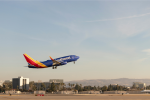Southwest Airlines Emergency Landing: What Happened on Flight 3006 Out of Houston
If you’ve flown recently or are planning a trip soon, here’s a story that might make you take a second glance at the safety card in your seatback pocket. On Wednesday, April 17, 2025, a Southwest Airlines flight bound for Cabo San Lucas had to make a quick return to Houston Hobby Airport after one of its engines caught fire shortly after takeoff.
While the situation was serious, the good news is that everyone on board made it out safely. But let’s break down exactly what happened, how the crew handled it, and what it means for travelers.
🛫 The Flight: Southwest 3006
Southwest Flight 3006 was scheduled for a routine trip from Houston, Texas to Cabo San Lucas, Mexico—a popular getaway route, especially as spring break and summer travel plans pick up. On board were 134 passengers, likely expecting little more than complimentary pretzels and ocean views a few hours later.
But shortly after takeoff, something went wrong.
🔥 The Emergency: Engine Fire Mid-Air
Not long after the Boeing 737 lifted off from Hobby Airport, passengers and crew reportedly heard an unusual sound from one of the engines. According to eyewitness accounts and official statements, there was visible smoke and possibly even flames coming from the right engine.
Within moments, the flight crew alerted air traffic control and declared an emergency. The pilots made the decision to turn back and land the plane as quickly and safely as possible—something they train extensively for but hope they never have to do.
🛬 The Landing: Back on the Ground in Houston
Thanks to swift action and clear communication, the aircraft was able to land back at Houston Hobby without further incident. But the story didn’t end there. Once on the runway, the crew initiated an emergency evacuation. That means passengers left the aircraft using the inflatable emergency slides—not something you see every day.
Photos and videos later circulated online showing the plane surrounded by emergency vehicles, with passengers standing on the tarmac, shaken but unharmed. Some people were reportedly treated for minor injuries related to the evacuation itself, but no serious injuries or fatalities were reported.
👩✈️ A Textbook Emergency Response
If you’ve ever wondered whether flight attendants do more than hand out snacks and demonstrate seatbelt use, this incident is a reminder of just how critical their training is. Within minutes, the Southwest crew executed a textbook evacuation, ensuring every single person got off the aircraft safely.
Pilots also followed protocol perfectly—cutting power to the affected engine, informing ground control, and landing as quickly and smoothly as possible.
The Federal Aviation Administration (FAA) has launched an investigation, as they always do in such cases, to determine the exact cause of the engine failure. Early speculation points to a mechanical malfunction, but it will take time for the full report to be completed.
🧠 What Should Travelers Take Away From This?
Incidents like this can be unsettling, especially when you’re a frequent flyer or planning a trip. But ironically, they also highlight just how safe modern air travel really is.
Here’s some perspective:
- Commercial airplanes are designed to fly with one engine if necessary. While losing an engine is serious, it’s something pilots are trained to handle, and planes are built to manage.
- Emergency evacuations are rare, but crews rehearse them regularly in simulators and training exercises.
- Most in-flight emergencies—engine fires included—end without fatalities.
So while the headlines may sound dramatic, the underlying story here is one of professionalism, training, and safety systems that worked exactly as intended.
💬 What Passengers Said
Several passengers shared their experiences after the evacuation. Many described a surreal moment of confusion and fear, followed by a deep sense of relief once they were safely on the ground. One traveler told local media, “The flight attendants were calm and direct. They got us out quickly, and honestly, I’m just grateful everyone’s okay.”
Others mentioned the smell of smoke and a strange noise shortly after takeoff, which quickly turned into the realization that something was wrong. Still, most agreed the crew handled it with professionalism and urgency.
🧳 What Happens Next?
For the passengers, Southwest rebooked flights and offered support for those who were understandably shaken. For the airline, this will prompt a thorough review—not just of the specific aircraft involved, but of maintenance practices and engine inspections across their fleet.
As for the FAA, their findings will eventually lead to recommendations or required fixes if a systemic issue is uncovered.
✈️ Should You Worry About Flying?
In short: no.
Air travel remains one of the safest modes of transportation on Earth. The fact that everyone walked away from this incident is proof of that. Accidents and malfunctions do happen, but they’re rare—and when they do occur, the layers of backup systems and human training are there to protect passengers.
If you’ve got a flight coming up, don’t panic. But maybe take a moment to glance at that safety card, watch the demonstration, and appreciate the calm professionalism of the crew. They’re not just there for your comfort—they’re trained to save your life if something goes wrong.
Final Thoughts
Flight 3006 was supposed to be a sunny trip to Mexico, and instead, it turned into an unplanned lesson in aviation safety. While no one wants to experience a mid-air emergency, it’s comforting to know that when the unexpected happens, modern aircraft, skilled crews, and strict safety standards are up to the task.
Here’s hoping everyone from that flight is relaxing on a beach right now—grateful, perhaps, with a little extra appreciation for the people who got them home safe.





